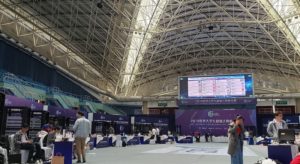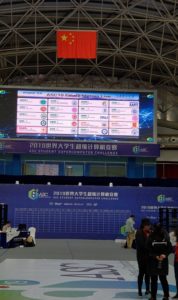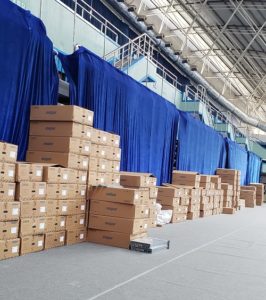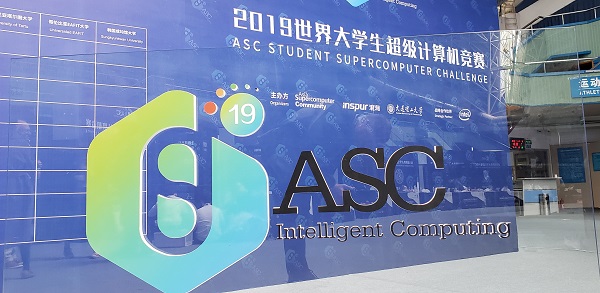Three thousand watts. That’s how much power the competitors in the 2019 ASC Student Supercomputer Challenge here in Dalian, China, have to work with. Everybody would like more juice to run compute-intensive HPC simulations and AI models, which means that whoever can get the most work done within the power constraints will take home the crown.
Twenty student teams from around the world have gathered here at the Dalian University of Technology to pit their computing abilities against one another in a no-holds-barred computational extravaganza. The event, which is hosted by the Asia Supercomputer Community (ASC) and sponsored by Inspur and Intel, started on Sunday and runs through Thursday, when the winners will be announced.
Just getting to this point is a victory of sorts for the undergraduates, but everybody would like to take home an award just the same. The ASC19 competition opened for registration in November with 300 student teams from 200 universities. The preliminary round kicked off in January and continued until early March, when the teams submitted their final proposals. A jury of HPC and AI experts with the ASC organization judged the proposals, and selected the final teams that are here this week.
The first two days of ASC (Sunday and Monday) are all about building the cluster, completing test runs, and dialing in the cluster for the actual competition, which runs mainly Tuesday and Wednesday. The configuration phase is a critical period for the teams, as they must determine which configuration will deliver the best performance against the various applications.
Whirl-Win
The sound of whirring fans fills the spacious indoor stadium here whenever one of the teams starts a test and the clusters ramp up. The teams check the results to see how the cluster ran, make some hardware or software tweaks, and repeat as necessary until they’re happy (or at least somewhat satisfied) with the setup.

The big challenge is to pick a cluster configuration that gives good results across all of the applications, or at least a cross-section of them. Dialing in that configuration involves balancing numerous variables, some of which are known and some of which are not. Once competition begins, the teams are not allowed to re-boot their clusters, although they can take action such as idling spare CPU or GPU nodes, which gives them some flexibility to adapt to different workloads while staying under 3,000 watts.
Each team is allowed to use as many servers as it wants. Boxes of Inspur servers are lined up against the bleacher seats, waiting to be racked and put into action. A maximum of 384GB of RAM is allowed, which most teams will probably use, and teams must supply their own hard drives (SSDs are a must).
The teams are allowed to use any internal networks they like. Most have chosen Mellanox interconnects, but one team has selected Intel OmniPath. Will it provide an advantage? Only time will tell.
ASC19 teams are also allowed to bring as many accelerators as they want to the competition. One team is rumored to have a large number of Nvidia V100 GPUs at the ready — effectively “loaded for bear.” But because of that pesky 3,000 watt limit, it’s unclear if the ASC19 winner will able to bring all that firepower to bear.
Strategic Configs
Some of the applications will clearly benefit from GPU computational power, while others will favor a lighter-weight approach. It all comes down to finding a strategic, or balanced, approach.

For example, one of the ASC19 applications is the single-image super-resolution (SISR) competition, which requires the teams to use the PyTorch deep learning framework to basically “up-convert” a series of blurry images into images with greater detail. Having a lot of GPUs here could be a boon.
Another prominent application that’s sure to stress the ASC19 teams is the Community Earth System Model (CESM), which is one of the main models used by the United Nations Intergovernmental Panel on Climate Change (IPCC). CESM is more of a “classic” HPC application, which may or may not benefit from GPUs.
The teams are eagerly awaiting the release of the actual data sets on Tuesday, which will go far in determining whether they made the right decisions in configuring their setups. Of course, by then it will be too late to make any major changes to their configuration.
Besides the CESM and the SISR tests, the teams must also prepare for other applications, including a WTDBG sequence assembly application; the HPL & HPCG high performance benchmarks; and the old standby benchmark, LINPACK. There is also one mystery application that will test the teams’ ability to adapt to the unexpected.
Except for the mystery application, the ASC19 competitors have known what applications, algorithms, frameworks, and codes they’re going to be working with here. That allows them to prepare, including by writing CUDA programs for AI and HPC applications. That’s why the release of the datasets early Tuesday morning is such a critical event. The data sets could be significantly bigger than what they’re used to dealing with, which could throw an interesting wildcard into the mix.
What’s At Stake
The computational tests take place Tuesday and Wednesday, and on Thursday morning the teams will make their presentation and mount a verbal defense against the jury. Later that day, the winners will be announced and a banquet will be held in celebration.
The prizes at play include the title of Champion, the Silver Prize, the Highest Linpack, the e-Prize, and the Group Competition, among other awards. There’s a total bonus of over $36,000 at stake.
As the students battle it out on the stadium floor for AI and HPC supremacy, there will be other events taking place, including the 21st HPC Connection Workshop and Artificial Intelligence & Supercomputing Innovation Symposium.
Speaking at the workshop will be Jack Dongarra, the chairman of the ASC Advisory Committee and a distinguished professor at the University of Tennessee, as well as University of California Berkeley expert Leon Chua.
The symposium, meanwhile, will feature Huchuan Lu, a professor at Dalian University of Technology, and Guohui Li, a researcher at the Dalian Institute of Chemical Physics in the Chinese Academy of Sciences.
The main event, though, involves the competition among the 300-plus students from around the world. The students hail from 15 universities in China and five from universities in other countries, including Germany (two), Poland, South Korea, and Columbia. Universities represented include:
- Beihang University, China

Boxes of Inspur servers line the wall of the ASC19 Finals this week in Dalian, China - Southern University of Science and Technology, China
- Fuzhou University, China
- Jinan University, China
- Shanghai Jiao Tong University, China
- Sun Yat-Sen University, China
- Taiwan Tsing Hua University, China
- Peking University, China
- Huazhong University of Science and Technology, China
- Shanxi University, China
- Taiyuan University of Technology, China
- University of Electronic Science and Technology of China, China
- The Chinese University of Hong Kong, China
- University of Warsaw / Warsaw University of Technology, Poland
- Tsinghua University, China
- Friedrich-Alexander-Universität Erlangen-Nürnberg, Germany
- University of Tartu, Germany
- Universidad EAFIT, Columbia
- Sungkyunkwan University, South Korea
- Dalian University of Technology, China
Stay tuned to HPCwire this week for more news from Dalian as ASC19 unfolds.





























































